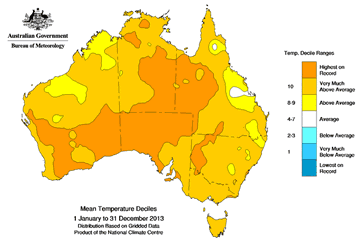Annual Climate Statement 2013

Yesterday the Bureau of Meteorology published its Annual Climate Statement 2013. Don’t be surprised to learn that it hasn’t been reported in the Murdoch media. And neither it should: it contains facts that counter the denialist claims often harped by its senior writers.
Australia boiled in 2013 yet the only references to the weather I can find on the front page of Murdoch’s news.com are that severe storms blanket the US in snow and that Canada is colder than Mars. Nice little stories, don’t you think, that shy away from what’s happening to the weather in Australia?
The Bureau’s Annual Climate Statement is too important to ignore. If the Murdoch media chose to conveniently ignore it then it is up to the independent media to disseminate it. I am producing it here in the hope that our readers do just that. The statement can be accessed through the above link. Below is a summary of the main findings:
Data collected and analysed by the Bureau of Meteorology show that 2013 was Australia’s warmest year on record while rainfall was slightly below average nationally.
- Summer 2012–13 was the warmest on record nationally, spring was also the warmest on record and winter the third warmest
- Overall, 2013 was Australia’s warmest year on record: annual national mean temperature was +1.20 °C above average
- All States and the Northern Territory ranked in the four warmest years on record
- Nationally-averaged rainfall was slightly below average for the year, with 428 mm (1961–1990 average 465 mm)
- Rainfall was mostly below average for the inland east and centre, and above average for the east coast, northern Tasmania and parts of Western Australia
Overview
2013 was Australia’s warmest year since records began in 1910. Mean temperatures across Australia have generally been well above average since September 2012. Long periods of warmer-than-average days have been common, with a distinct lack of cold weather. Nights have also been warmer than average, but less so than days.
The Australian area-averaged mean temperature for 2013 was +1.20 °C above the 1961–1990 average. Maximum temperatures were +1.45 °C above average, and minimum temperatures +0.94 °C above average. Temperatures were above average across nearly all of Australia for maximum, mean and minimum temperatures, with large areas of inland and southern Australia experiencing the highest on record for each.
Australia has experienced just one cooler-than-average year (2011) in the last decade. The 10-year mean temperature for 2004–2013 was 0.50 °C above average, the equal-highest on record. Averages for each of the ten-year periods from 1995–2004 to 2004–2013 have been amongst the top ten records.
The Australian mean rainfall total for 2013 was 428 mm (37 mm below the long-term average of 465 mm). In comparison with rainfall in all years since 1900, 2013 sits close to the median or mid-point of historical observations.
Annual rainfall was below average across a large region of the inland east centred on western Queensland and extending into northern South Australia and the Northern Territory. Rainfall was above average over parts of the Pilbara and the south coast of Western Australia, as well as along the east coast and northern Tasmania.
This cannot be ignored.